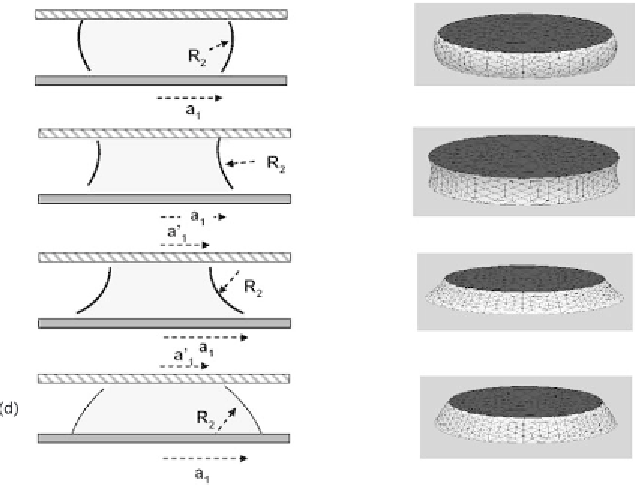Biomedical Engineering Reference
In-Depth Information
Shape of a Droplet Constrained Between Two Horizontal Planes
A droplet squashed between two parallel plates has two types of contact: one with
the bottom plate and another with the top plate. These contacts can be indepen-
dently either wetting or nonwetting depending on the material of the substrates.
Figure 3.50 shows different possibilities and the corresponding shapes calculated
using the Surface Evolver numerical software.
Let us derive the expression of the curvature radius in the vertical plane. This
curvature radius is shown in Figure 3.51 for the morphology of Figure 3.50(d).
Remarking that angles with perpendicular sides are equal, we can write
R
cos
q
1
=
H
-
d
, where
H
is the distance between the curvature center and the upper plate and
d
is the gap between the plates; similarly
R
cos(
π
-
q
2
) =
R
cos
q
2
=
H
. We deduce the
value of the curvature radius
R
δ
R
= -
(3.76)
cos
θ
+
cos
θ
1
2
In the case of a concave interface corresponding to
q
1
<
π
/2,
q
2
>
π
/2, and
q
1
+
q
2
<
π
[Figure 3.51(b)], similar reasoning leads to the negative curvature radius
δ
R
=
cos
θ
+
cos
θ
1
2
In the particular case where
q
1
+
q
2
=
π
[Figure 3.51(c)], the vertical profile of
the interface is flat (the interface has a conical shape) and the curvature radius is
infinite.
Figure 3.50
Sketch of the shape of a drop between two horizontal plates. Four different cases
are observed: (a) hydrophobic contact with both plates; (b) hydrophilic contact on both plates;
(c) hydrophilic contact on bottom plate, hydrophobic contact on top plate and a concave interface
(
q
1
<
π
/2,
q
2
>
π
/2, and
q
1
+
q
2
<
π
); and (d) the same situation as (c), but the interface is convex (
q
1
<
π
/2,
q
2
>
π
/2, and
q
1
+
q
2
>
π
).







